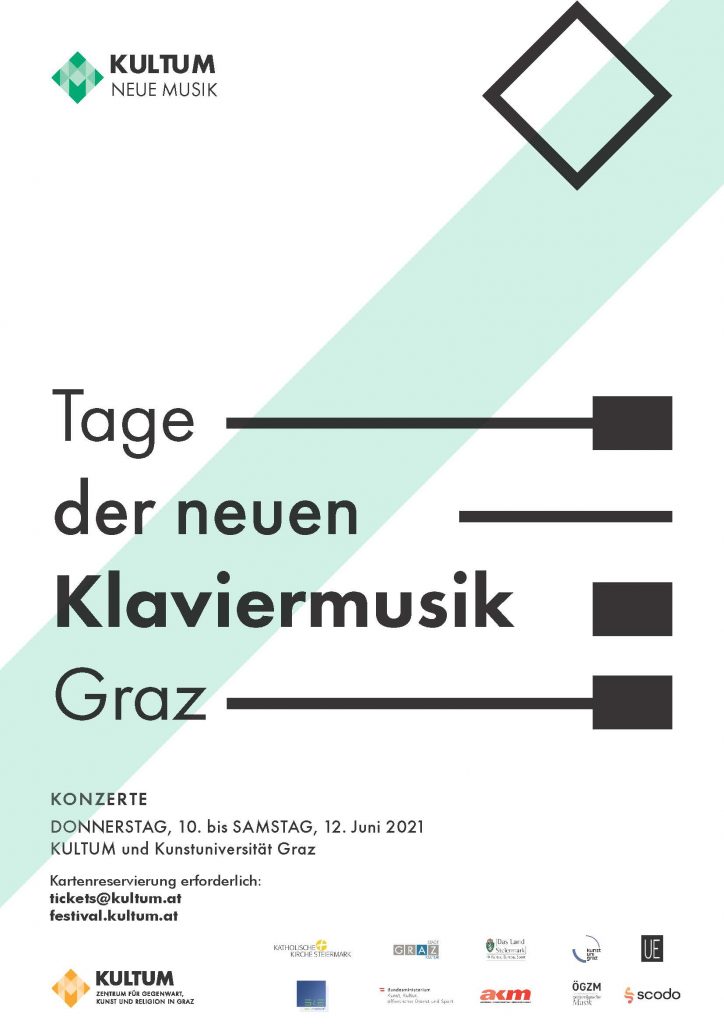
Frankly, I’ve really missed staging something in the past months. On June 11, I’ll make a comeback as pianist with works by Richard Dünser, Katharina Roth and two books of my work XXI Oracles of the Night — in the course of which the second book is being premiered. Having been studying the pieces for more than half a year, I’m definitely looking forward to playing these works in public. All the pieces orbit arount the subject «Nocturne». I was looking for a programme that conveys faintly Romantic emotional worlds and sinisterly obscure soundscapes respectively.
Admittingly I tend to enjoy contemporary music that does not sound as we might expect modern music to be like. Music that seems to have fallen out of time can be extremely exciting—as long as it doesn’t present itself unprogressive or even reactionary. As a composer, I believe in individual solutions, in personal styles that might be arbitrary or just unfashionable and I assume that almost every great artist cannot be confused with another artist, due to his or her most individual compositional strategies. Naturally, composing successfully in the spirit of the time is repugnant to that idea to a certain extent.
a Saturn gong, four singing bowls and several mallets.
When working on my second book of XXI Oracles of the Night I have intensively meditated on harmonic clarity. We need structures that are recognizable and such structures that are apt to cause nebulosity at the same time. On the one hand, I added rather complex harmonies to my pieces using a planet gong and four singing bowls and melted these tonal colours with the equal-tempered tones of the piano. When writing for the piano and designing harmonic progressions, we must always consider the usage of the pedal as well. Thus the actual sounding result might be far more complex than what’s apparently written in the score—just have a think about it. The crucial thing, and I daresay the more difficult thing, is how to establish harmonic clarity while using the pedal function unstintingly. There are several strategies I chose to accomplish this task:
- (a) Writing rather simple chords. Seems easy, but isn’t really. Take a major triad. It will easily come to the foreground, but everyone will think «Oh, a lovely triad—how boring!». We can circumvent that problem to a certain degree by mixing a triad together with another simple chord. This results in Sacre-like chords (comp. Stravinsky: Le Sacre du Printemps, mark 13f.). Furthermore we might consider accelerating the tempo of chord progressions while still holding down the pedal. Quite effective, rather difficult to play, yet the result will eventually become more and more obscure.
- (b) Reducing the texture and the speed respectively. Morton Feldman is unsurpassed in applying this method in order to create transparent structures and patterns. When working with very complex chords (with pitches that deviate from the twelve chromatic tones) this is a nice way to grant the listener some time to understand what’s happening harmonically. The problem is, it is in contradiction to classic virtuosity to some extent.
- (c) Using primitive scales. I really avoided writing diatonic structures thus far. It’s like touching the fire: One might get burned easily. We all know what the white keys sound like and we all have grown accustomed to the sound of a pentatonic scale really well. It’s become dull. However, in the middle of a a harmonic mess (remember, let’s keep the right pedal down for a while), such primitive structures might just establish the smidge of clarity we were striving to. Combining (a) and (c) in Presto or Agitato can result in very interesting, very complex and very exciting passages, I have found out. The vital question is: How long can a structure based on a primitive scale last at the maximum? In my work, I escaped my diatonic structures within five seconds, and additionally they are always flanked by something else such as a (microtonally deviant) stroke of the gong etc.
Other than that, in XXI Oracles of the Night, I was aiming at bringing allusions to esotericism into my music. On the one hand, the titles of the single movements such as The Solar Wind in the second book by themselves evoke the idea of an unearthly something happening around us. I did my best to translate such overtones into my piano pieces. Observed from a musical point of view, they become audible in the instrumentation for the one thing. Planet gongs and singing bowls are closely assiciated with a certain utilization context. The other idea of how to include the allurement of a possibly supernatural existence was to play around with musical clarity. Whenever we feel we could hang on to a theme, a chord, a tonality, whatsoever, the music descends elsewhere. It only gives us hints, some of which are stronger, others scarcely discernible.
Concert: Orakel der Nacht
Friday, June 11 2021, 9:00 PM
KULTUM, Mariahilferplatz 3, 8020 Graz